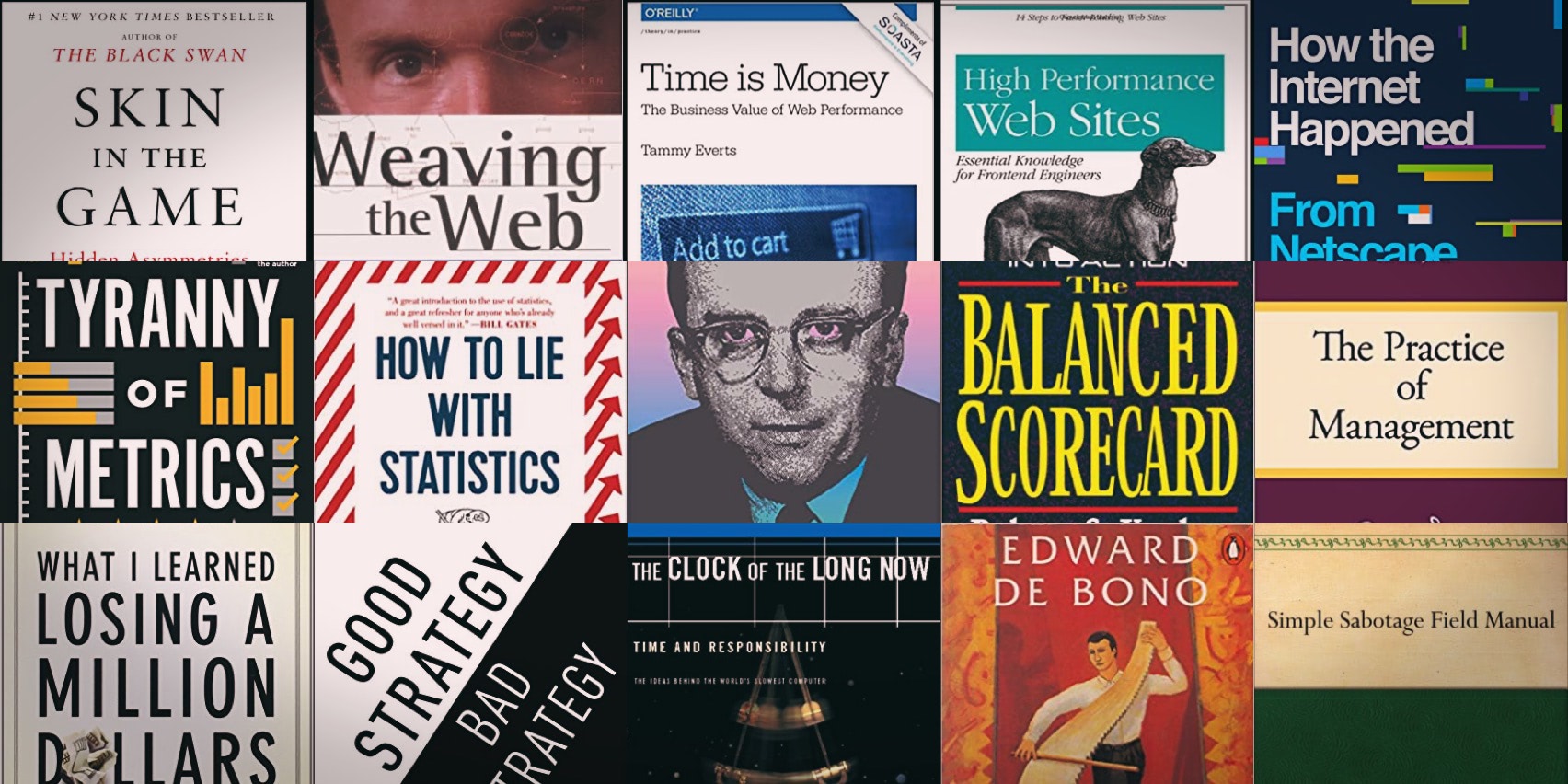2021 was surreal, even more than 2020, like a quasi-back-to-normal fever dream.
Literally day one, New Year’s Day, my mom, brother and his wife, all tested positive for COVID. Luckily their symptoms were (mostly) mild, but still… A few days later, shortly after I posted Looking Back 2020, we watched a mob storm the U.S. Capitol.
Hell of a way to start the year.
2021, for me, was long… longer than 2020, for sure. And now, at the end of it, looking back, I just feel tired…
Last year my goal was to make people smile. Hopefully I did that, at least in some small ways, lighting little sparks of joy for the people around me. But honestly, 2021 made it hard to smile. We lost so many loved ones this year. Quiet prayers, distant goodbyes…
My 30th year was a Pollock painting. For 2022, I just want to work less, live more.
Happy New Year.
Jump to: Personal, Books, Music, Code
Personal
Writing A Book
Most of my year was consumed with thoughts of writing a book. It’s frustrating because all I have to show for it are notes, tweets, an obscure blog, and a measly sample of work at catchingup.dev. But I’m holding out. I have hope that, however long this takes, I’ll eventually finish. It’s just a matter of taking the time to see it through.
For now, I’m happy I got Request for a General Theory of Web Performance into this year’s Web Performance Calendar—and Alex Russell wrote a response! That helps me feel like I’m at least headed in the right direction.
I was also happy to see my WebPageTest t-shirt make it into the official WebPageTest store. It’s the little things. 🙂
Open Source Projects
To help keep my sanity, break from the slog of research and rewriting, I jumped back into some of my side projects—and was surprised to see some of them actually getting traction:
- Snap Slider got feedback in GitHub, a shoutout on Twitter, and I finally started work on version 3.
- Match Height got feedback in GitHub too. (It’s wild how much comments mean when you first begin sharing your work online.)
- Twitter Print Styles got a request for a Firefox extension.
- GitHub Wiki Search, just because I really wanted it, got a Safari extension too. (Shoutout to Thomas Steiner and Timothy Hatcher for helping me get through the App Store process!)
Black Magic Dev
I’ve been wanting to share what I’ve learned as a web developer for years now—document everything I’ve learned for others to learn too. I bought a domain back in 2020, but never got around to actually sharing anything. This year I finally got it started:
I call it blackmagic.dev.
It’s literally just one video right now (Fixing iOS 15 Scroll Jank) but it’s a start. As I work on Catching Up, I plan on taking breaks to share other code stuff there (things like Cross-Browser Extensions, Mac Shortcuts, and WordPress Deep Dives).
Everything’s moving slowly, but we’re getting there.
Just Things
Another random hobby: over Thanksgiving break I started a Twitter account called Just Things. Every morning, I post a random, unfair comparison of two things. For example: “Penguins are just snow chickens.”
Friends and neighbors praise its deadpan humor:
- “A great feed for stoners.”
- “This opened a spigot in my brain.”
Who knows, maybe it’ll catch on. Maybe I’ll make t-shirts. Or maybe this is my first step into a descent of madness…
Home Improvements
Speaking of madness, how about 2021 lumber prices, am I right? Welcome to home ownership!
Between a broken dishwasher, rotten siding, moldy garage, broken closet, cracked furnace, and busted kitchen pipes, we had a hell of a year paying for home improvements. (Oh yeah, and don’t forget about the leaking toilet, broken garage door, and warped hardwood floor—we’re saving those for 2022.)
It’s been a year.
Shoutout to our friends at F2 Construction for helping us through all our major projects.
Family, Friends, and Firsts
COVID, vaccines, gardens, and summer pool parties. Lots of Harry Potter and back to school. Puzzles, costumes, and no more training wheels. Vacation with friends and drinks with neighbors.
For as much stress as 2021 brought on, we still had lots of good—and lots of firsts. We had our first time back at the grocery store, first time back in the office, first time back in school, first time taking Remi to the dog park, first time back in a theater, first real Halloween trick-or-treating with friends, first semi-post-COVID date night, and so on…
(By the way, great idea for birthdays: send an Uber Eats gift delivery—an actual order, not a gift card!—or an exploding birthday cake. Those have been fun.)
The kids have been growing like crazy. Jackson and I played through the first three Halo games. Ruby’s basically making selfie short films. Both of them are making comics, writing stories, and crafting like mad. Lord knows what they’ll be up to next year—they’re practically grown. It’s hard to believe they were babies just a few short years ago.
It’s been a long year, but Brianne and I are hopeful, and looking forward to a bright 2022.
P.S. There’s so much I’ve left out of this recap—things like Florida’s dead fish—it almost feels wrong. But I’ve got to cut it somewhere. Let’s talk more together offline.
Books
Here are all the books I read this year, in the order I finished them.
-
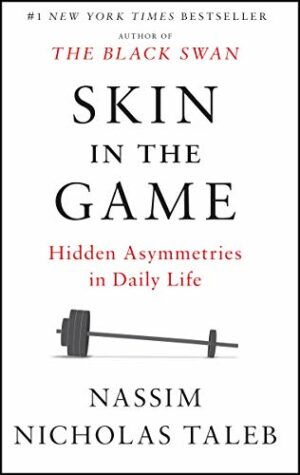 Skin in the Gameby Nassim Nicholas Taleb
Skin in the Gameby Nassim Nicholas Taleb Exploring asymmetries and their consequences. How trying to fix problems you don’t have risk in just creates more problems. Verges on ranting at times, but insightful and important.
- “If you have the rewards, you must also get some of the risks, not let others pay the price of your mistakes.”
- “The Golden Rule wants you to Treat others the way you would like them to treat you. The more robust Silver Rule says Do not treat others the way you would not like them to treat you.” … “What is hateful to you, do not do to your fellow: this is the whole Torah; the rest is the explanation; go and learn.” Rabbi Hillel the Elder drawing on Leviticus 19:18.
- “The average behavior of the market participant will not allow us to understand the general behavior of the market… Price changes reflect the activities of the most motivated buyer and seller.”
- “What can we do since a centralized system will necessarily need people who are not directly exposed to the cost of errors? Well, we have no choice but to decentralize or, more politely, to localize; to have fewer of these immune decision makers… Decentralization reduces large structural asymmetries.”
Glossary:
- Interventionista: Someone who causes fragility because he thinks he understands what’s going on. He is not exposed to the filter and discipline of skin in the game.
- Minority Rule: An asymmetry by which the behavior of the total is dictated by the preferences of a minority. Smokers can be in smoke-free areas but nonsmokers cannot be in smoking ones, so nonsmokers will prevail, not because they are initially a majority, but because they are asymmetric. (See also: a disabled person will not use the regular bathroom, but a nondisabled person will use the bathroom for disabled people.)
- Via negativa: The principle that we know what is wrong with more clarity than what is right, and that knowledge grows by subtraction. Also, it is easier to know that something is wrong than to find the fix. Actions that remove are more robust than those that add because addition may have unseen, complicated feedback loops.
A Brief Tour of Your Grandparents’ Wisdom:
- Cognitive dissonance: How we deal with inconsistent or contradictory thoughts, beliefs, feelings (e.g., sour grapes).
- Loss aversion: A loss is more painful than a gain is pleasant.
- Negative advice (via negativa): We know the wrong better than what’s right (e.g., Silver Rule vs Golden Rule).
- Skin in the game: “You can’t chew with somebody else’s teeth.” —Yiddish proverb
- Antifragility: The resilient resists shocks, the antifragile gets better.
- Time discounting: “A bird in the hand is better than ten on the tree.” —Levantine proverb
- Madness of crowds: Madness is rare in individuals, but in groups, parties, nations, it is the rule. —Nietzsche
- Less is more: Truth is lost with too much altercation. —Publilius Syrus
- Overconfidence: “I lost money because of my excessive confidence.” —Erasmus
- Paradox of progress / Paradox of choice: “If you worked harder, you could relax sooner.” “But I’m already doing that.” (e.g., story of the fisherman).
-
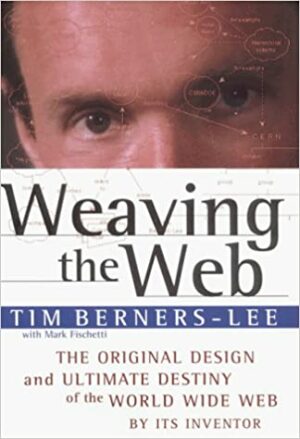 Weaving the Webby Tim Berners-Lee
Weaving the Webby Tim Berners-Lee Tim Berners-Lee’s history of the Web—his years experimenting, developing, organizing, and inviting others to grow it into the global information system it is today.
Fascinating look into the human side of the Web, its precursors, failed attempts, discouragements, breakthroughs, and vision for the future.
The story of how Robert Cailliau salvaged an Internet connection for their Web demo at Hypertext ’91 is legendary. And the stories of standards, the W3C, and all of the business and politics surrounding the Web is especially interesting—I’ll have to share more another time!
- “The Internet was up and running by the 1970s… When the World Wide Web arrived, riding on top of the Internet, it would give information a place to persist.”
- “What matters is in the connections.”
- “The fundamental principle behind the Web was that once someone somewhere made available a document, database, graphic, sound, video, or screen at some stage in an interactive dialogue, it should be accessible (subject to authorization of course) by anyone, with any type of computer, in any country. And it should be possible to make a reference—a link—to that thing, so that others could find it.”
- While others focused on avoiding broken links… “I was looking at a living world of hypertext, in which all the pages would be constantly changing. It was a huge philosophical gap. Letting go of that need for consistency was a crucial design step that would allow the Web to scale.”
- “We wanted to be able to say that if something was on the Web, then anyone could have access to it—not just anyone with a NeXT [computer]!” For example, the first browser, the line-mode browser, was “so basic that it could even work on a paper Teletype.”
- “[To] demonstrate the Web as a universal, all-encompassing space… I programmed the browser so it could follow links not only to files on HTTP servers, but also to Internet news articles and newsgroups… In one fell swoop, a huge amount of the information that was already on the Internet was available on the Web.”
Simple Rules for Global Systems:
- Universal Resource Identifier: Give everything on the Web an address so anyone can link to it.
- Hypertext Transfer Protocol: Agree on a standard way for computers to share Web resources.
- Hypertext Markup Language: Provide a common language for representing data on the Web.
P.S. Here’s a fun, early example of web performance:
“I therefore defined HTTP, a protocol simple enough to be able to get a Web page fast enough for hypertext browsing. The target was a fetch of about one-tenth of a second, so there was no time for a conversation. It had to be ‘Get this document,’ and ‘Here it is!’”
-
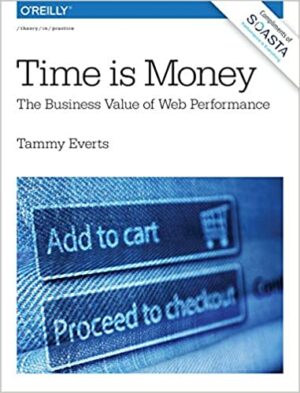 Time Is Moneyby Tammy Everts
Time Is Moneyby Tammy Everts Excellent primer on web performance.
Opens with why site speed matters, the psychology behind it and the business case for it. Moves on to case studies and the technical details behind site speed. (Surprise! Bandwidth doesn’t solve all problems…) Ends with a look to the future and the big questions our industry is working to answer—all in less than 100 pages.
Best Part: This book is explicitly written for non-engineers, which makes it perfect for new engineers.
Any engineer looking to get into web performance should at least read Chapters 4 and 5: a brief history of web performance, the current landscape, and big questions for the future. It’s context few take the time to share, but Tammy delivers. (Fun Fact: Core Web Vitals isn’t totally new—Google has been ranking site speed since 2010.)
Front-End Optimization:
- Reduce the number of HTTP requests required to fetch the resources for each page (by consolidating resources).
- Reduce the size of the payload needed to fulfill each request (by compressing resources).
- Optimize client-side processing priorities and improve script execution efficiency (by ensuring that critical page resources load first, and deferring noncritical resources).
- Target the specific capabilities of the client browser making each request (such as by leveraging the unique caching capabilities of each browser).
Big Questions:
- “Are we always measuring the right things? How fast is fast enough?” … “The only way to answer the question ‘How fast is fast enough?’ is to come up with a set of metrics for ‘fast enough’ that work for your company and your visitors.”
- “Not all web pages are created equal… While it would be wonderful if we could optimize every single page of our websites, most site owners have only a finite amount of optimization resources. You need to focus those resources on optimizing the pages that matter most to your bottom line.”
- “There is no such thing as an average user. Every user experience is different. And every site delivers both great and terrible user experiences to users every day. Real user monitoring measures the broad spectrum of user experiences. Synthetic performance tests give you snapshots of user experiences within very specific parameters. Understanding what each type of performance measurement tool can help you with is the key to using each to its best advantage.”
- “The performance industry needs to correlate load time with other metrics that are meaningful to your business, and develop more tools that can weight your results so that site owners know what pages to tackle first to get the best ROI for their optimization efforts.”
-
 High Performance Websitesby Steve Souders
High Performance Websitesby Steve Souders The bible for front-end performance. Released in 2007, its recommendations still hold up as best practices for page speed optimization.
Only 10–20% of the end user experience is spent downloading the HTML document. The other 80–90% is spent downloading all the components in the page.
There’s so much more to say about this book, but, in honor of its simplicity, I’ll stick with highlighting its 14 rules (and rephrasing where more “modern” terms apply).
- Make fewer HTTP requests.
- Use a Content Delivery Network (CDN).
- Add an Expires header (i.e., enable HTTP caching).
- Gzip components (i.e., enable HTTP compression).
- Put stylesheets at the top (i.e., prioritize render-blocking styles).
- Put scripts at the bottom (i.e., defer scripts).
- Avoid CSS expressions (i.e., simplify style calculations).
- Make JavaScript and CSS external.
- Reduce DNS lookups.
- Minify JavaScript (i.e., minify code).
- Avoid redirects.
- Remove duplicate scripts.
- Configure ETags (i.e., optimize HTTP caching).
- Make AJAX cacheable (i.e., optimize HTTP caching).
-
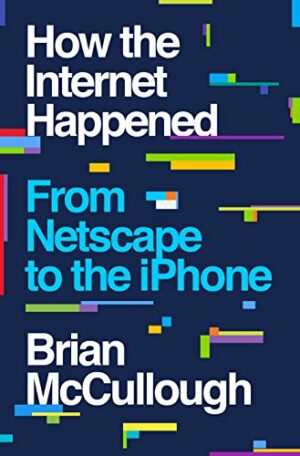 How the Internet Happenedby Brian McCullough
How the Internet Happenedby Brian McCullough Picking up where The Dream Machine ends (circa 1990), this book tells the story of the Internet and, in particular, the World Wide Web:
“This is not a history of the Internet itself, but rather, a history of the Internet Era, that period of time from roughly 1993 through 2008 when computers and technology itself stopped being esoteric and started becoming vital and indispensable.”
Check out the Internet History Podcast!
- 1993: “Software, at the time, meant floppy discs or CDs sold in cardboard boxes at retail… But the Mosaic team… had discovered that you could dream up a product, code it, release it to the ether and change the world overnight… In the web world, development schedules could be measured in weeks.”
- 1995: “The Netscape IPO was the big bang that started the Internet Era. That picture of a barefoot Marc Andreessen on the cover of Time was what started young geeks dreaming of Silicon Valley riches.”
- 1996: “AOL was where Americans first wrestled with concepts of anonymity and identity in an online world.”
- 1997: “The biggest lesson to learn about online media was the 24/7 nature of the beast. The tragic 1997 death of Britain’s Princess Diana was the media sensation of its day, and not just for traditional outlets like the Times. Online news sites like Pathfinder saw their traffic numbers spike as distraught readers went online to absorb any and all details they could find.”
- 1999: “What so entranced these early adopters of the BlackBerry was just that ability to always be connected to information. It’s the reality we’re all familiar with today: the phenomenon of never being out of touch. But in the early 2000s, this was a new experience.” … “During the terrorist attacks of 9/11 [2001], most cell service went down, but BlackBerry users could still get their messages out. Congress subsequently bought BlackBerrys for every senator, representative and thousands of Capital Hill staffers, such was BlackBerry’s reputation for keeping people in the know.”
- 2000: “Napster was like a supernova that exploded across the tech, media and cultural landscape just as the dot-com bubble burst in the year 2000.”
- 2001: “Steve Jobs unveiled the iPod on October 23, 2001… Combined with the iTunes software app, users would have full control over their digital music collections.”
- 2003: “Opening up the iPod and iTunes to Windows was the turning point that set Apple on the path to becoming the biggest, most profitable company in the world.”
- 2003: “A new technology called WiFi arrived on the stage to make the notion of surfing the web something that felt ubiquitous and commodified.”
- 2003: “When Friendster users grew frustrated waiting thirty or more seconds for pages to load, they had a throng of Friendster copycat sites to turn to instead… One of the copycat sites that rushed in to tempt away disillusioned Friendster users was called Myspace.”
- 2004: “Thefacebook passed the million-user mark. It had been live for all of ten months… The same month that Thefacebook hit 1 million users, Myspace hit 5 million.”
- 2004: “This new Internet energy gained the name Web 2.0, after a similarly named conference held in October 2004. If Web 1.0 was about browsing stuff created by others, Web 2.0 was about creating stuff yourself.”
- 2005: “Facebook Photos was launched in October of 2005… Within three weeks, Facebook hosted more photos than Flickr. After a month, 85% of the service’s users had been tagged in at least one photo.”
- 2006: “YouTube’s audience exploded faster than any previous website in history (including Google, Myspace and Facebook). By the beginning of 2006, the site was serving 3 million video views a day. Six months later, that number had grown to 100 million views a day.” … “Google made one simple calculation when it purchased YouTube: in the broadband era, video was likely to become as ubiquitous on the web as text and pictures had always been. YouTube was already, in essence, the world’s largest search engine for video.”
- 2007: “An iPod… a phone… and an Internet communicator… An iPod… a phone… are you getting it? These are not three separate devices. This is one device! And we are calling it iPhone.” … “Jobs himself would later say the miracle of mobile browsing was what truly made the first iPhone stand out. The iPhone delivered the ‘real’ Internet like a ‘real’ computer did. The iPhone finally made the mobile web a self-evident, useful feature. ‘It’s the Internet in your pocket for the first time,’ Jobs said.”
Manias & Infrastructure:
“Many observers of the dot-com bubble have found it instructive to compare it to earlier bubbles like the tulip mania in seventeenth-century Holland or the South Sea Company’s collapse in eighteenth-century London. But it’s the example of the railroads in Britain in the 1840s that’s the most analagous… The bubble, and the railroads constructed because of it, ultimately created the infrastructure that would enable the high Industrial Revolution in Victorian Britain… The railways never went away, even after the investment mania did. The lesson of the dot-com bubble is similar… All of the money poured into technology companies in the first half decade of the Internet Era created an infrastructure and economic foundation that would allow the Internet to mature.”
The Death of High School Reunions:
“The one personal anecdote I’ll share in this book: that summer of 2006 was my ten-year high school reunion. It was an important event. Many of my classmates had lost touch with each other. There were a lot of ‘Wow! What happened to you?’ conversations… Ten years later, our twenty-year high school reunion in 2016 was less of an event. It was more of ‘Hey, I saw the photo of your new car yesterday’ than it was ‘Where have you been?’ After all, thanks to Facebook, I now get updates about everyone on an hourly basis… There is a very clear demarcation point to my social life between pre-Facebook times and post-Facebook times, and it felt like the change happened overnight.”
From dot-com to COVID:
“Far from being a fad, the habits Americans acquired during the bubble era ingrained themselves into the rhythms of everyday life. The dot-coms, the training wheels for the Internet, the pioneers, they all taught us to live online. We all might have jumped from dial-up to broadband, but few of us quit using the net. There was no going back.”
-
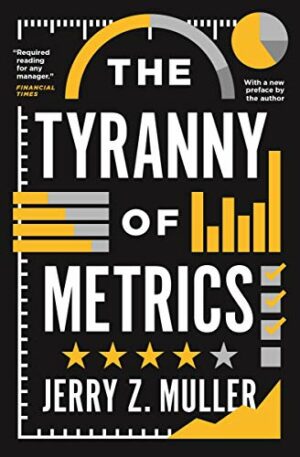 The Tyranny of Metricsby Jerry Z. Muller
The Tyranny of Metricsby Jerry Z. Muller I found this book thanks to Katie Sylor-Miller’s post, The Core Web Vitals hype train, and Gergely Nemeth’s book summary.
“Used properly, measurement, as we’ll see, can be a good thing. So can transparency. But they can also distort, divert, displace, distract, and discourage.”
“Not everything that can be counted counts, and not everything that counts can be counted.”
- “What gets measured is what gets attention.”
- “Metrics go awry when they are used mechanically by those who are not in a position to evaluate the accuracy and significance of the data.”
- “Coming up with useful metrics often requires an immersion in local conditions.”
Recurring Flaws:
- Measuring the most easily measurable. (“Measurability bias”.)
- Measuring the simple when the desired outcome is complex.
- Measuring inputs rather than outcomes.
- Degrading information quality through standardization.
- Gaming through “creaming”. (Preferring easier cases, excluding cases where success is more difficult to achieve. “The superior surgeon uses his superior judgment to steer clear of any situation that might test his superior ability.”)
- Improving numbers by lowering standards.
- Improving numbers through omission or distortion of data.
- Cheating.
Negative Consequences of Performance Metrics:
- Goal displacement through diversion of effort to what gets measured.
- Promoting short-termism.
- Costs in employee time.
- Diminishing utility.
- Rule cascades. (Too many rules.)
- Rewarding luck.
- Discouraging risk-taking.
- Discouraging innovation.
- Discouraging cooperation and common purpose.
- Degradation of work.
- Costs to productivity.
When and How to Use Metrics:
- What kind of information are you thinking of measuring? Inanimate objects are more measurable. Beware objects that are influenced by the process of measurement.
- How useful is the information? Is what you’re measuring a good proxy for what you really want to know? If not, better off not measuring it.
- How useful are more metrics? More isn’t always better. Beware the cost of measurement exceeding its benefits.
- What are the costs of not relying upon standardized measurement? Consider other sources of information, like the judgement and experience of stakeholders.
- To what purposes will the measurement be put, or to put it another way, to whom will the information be made transparent? “For example, is crime data being used to discover where the police ought to deploy more squad cars or to decide whether the precinct commander will get a promotion? Or is a surgical team using data to discover which procedures have worked best or are administrators using that same data to decide whether the hospital will be financially rewarded or penalized for its scores?” … “Measurement is most useful for internal analysis by practitioners rather than for external evaluation by public audiences who may fail to understand their limits.” Beware gaming, fraud, and goal displacement.
- What are the costs of acquiring the metrics? “Collecting data, processing it, analyzing it—all of these take time, and their expense is in the opportunity costs of the time put into them.” … “Even if the performance measurements are worth having, their worth may be less than the costs of obtaining them.”
- Ask why the people at the top of the organization are demanding performance metrics. Sometimes it’s simply because executives lack particular knowledge of your industry. Avoid “parachuting”. Consider hiring from within instead.
- How and by whom are the measures of performance developed? Metrics are best developed bottom up, with input from practitioners. “Measured performance works to the extent that the people being measured believe in its worth.”
- Remember that even the best measures are subject to corruption or goal diversion. But we shouldn’t abandon metrics just because they have some negative outcomes. “It’s a matter of trade-offs. And that too is a matter of judgment.”
- Remember that sometimes, recognizing the limits of the possible is the beginning of wisdom. “Not all problems are soluble, and even fewer are soluble by metrics.”
“As we’ve seen time and again, measurement is not an alternative to judgment: measurement demands judgment: judgment about whether to measure, what to measure, how to evaluate the significance of what’s been measured, whether rewards and penalties will be attached to the results, and to whom to make the measurements available.”
“Ultimately, the issue is not one of metrics versus judgment, but metrics as informing judgment, which includes knowing how much weight to give to metrics, recognizing their characteristic distortions, and appreciating what can’t be measured.”
P.S. Here’s some more performance trivia:
“In the [1990s], ‘accountability’ and ‘performance measurement’ became buzzwords among business leaders, politicians, and policymakers in the United States as well. In 1993, President Bill Clinton signed the Government Performance and Results Act, which required all agencies to develop mission statements, long-range strategic plans, and annual performance goals, together with descriptions of the measures to be used to gauge progress toward those goals.”
-
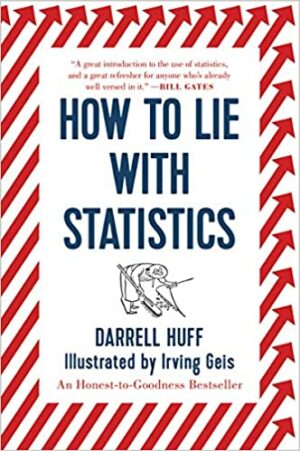 How to Lie with Statisticsby Darrell Huff
How to Lie with Statisticsby Darrell Huff Delightful primer on the misuse of statistics.
“There are three kinds of lies: lies, damned lies, and statistics.” —Disraeli
“It ain’t so much the things we don’t know that get us in trouble. It’s the things we know that ain’t so.” —Artemus Ward
Ten Ways Statistics Lie:
- The Sample with the Built-in Bias: Ideally, you want a representative sample, but those are often too difficult or expensive to get. Hence bias… “No conclusion that ‘sixty-seven percent of the American people are against’ something or other should be read without the lingering question, Sixty-seven percent of which American people?”
- The Well-Chosen Average: “When you are told that something is an average you still don’t know very much about it unless you can find out which of the common kinds of average it is—mean, median, or mode.” Fact: 95% of a population can have below average income. 🤯 (Medians are often the most informative average.)
- The Little Figures That Are Not There: Beware statistics that leave out information like sample size, degree of significance, deviation, range, or even labels, definitions, etc. “The deceptive thing about the little figure that is not there is that its absence so often goes unnoticed.”
- Much Ado about Practically Nothing: “Sometimes the big ado is made about a difference that is mathematically real and demonstrable but so tiny as to have no importance. This is in defiance of the fine old saying that a difference is a difference only if it makes a difference.” (For example, IQ.)
- The Gee-Whiz Graph: How to crop, stretch, and skew graphs so they appear drastically more impressive. “Of course, the eye doesn’t ‘understand’ what isn’t there, and a small rise has become, visually, a big one.”
- The One-Dimensional Picture: How pictographs can be even more misleading. “One figure was twice as tall as the other and so would have had eight times the bulk or weight… While saying ‘twice,’ I have left the lasting impression of an overwhelming eight-to-one ratio.”
- The Semiattached Figure: My favorite chapter. “If you can’t prove what you want to prove, demonstrate something else and pretend that they are the same thing.” How spurious correlations show up over and over again.
- Post Hoc Rides Again: My second favorite chapter. “The [post hoc fallacy] says that if B follows A, then A has caused B.” For example, “there is a close relationship between the salaries of Presbyterian ministers in Massachusetts and the price of rum in Havana. Which is the cause and which is the effect?”
- How to Statisticulate: “Misinforming people by the use of statistical material might be called statistical manipulation; in a word (though not a very good one), statisticulation.” How to hide behind false precision, percentages, shifting bases, and other clever tricks.
- How to Talk Back to a Statistic: The coup de grâce. So good, it gets its own dedicated section below…
How to Talk Back to a Statistic:
- Who Says So? Look for bias, conscious or otherwise.
- How Does He Know? Is the sample large enough? Is it representative? Are the correlations significant?
- What’s Missing? Look for measures of reliability. Beware unspecified averages. Look for comparisons that provide context and meaning. Don’t settle for percentages. This is the biggest danger zone…
- Did Somebody Change the Subject? Beware semiattached figures and post hoc. “What the Ministry really found out is how often these people said they bathed, not how often they [actually] did so.”
- Does It Make Sense? Use your judgement. Beware unproved assumptions. “Many a statistic is false on its face. It gets by only because the magic of numbers brings about a suspension of common sense.”
-
 The Dream Machineby M. Mitchell Waldrop
The Dream Machineby M. Mitchell Waldrop Incredible, sweeping history of computers—J. C. R. Licklider lived through it all, from early analog computers to the birth of the Internet.
A must-read for software engineers.
“Once upon a time, to get a computer to do your bidding, you had to punch holes in paper cards or tapes, give the paper to someone who fed it to the machine, and then go away for hours or days. Lick believed we could do better and, more than any other single individual, saw to it that we did.”
“A rising generation of computer-science students began to think of computers as liberating. This was the generation that would build the Arpanet. This was the generation that would gather at PARC. And this was the generation—together with the students it would teach—that would engineer the personal-computer revolution of the 1980s and the networking revolution of the 1990s.”
From Computing Machines to Computers:
- “So far, from Babbage’s Analytical Engine in the 1830s through ENIAC in the 1940s, digital computers had always been conceived of as calculating machines… [They] were still designed to take in data for one specific problem at a time, grind away until they spit out an answer, and then stop and wait for new input.”
- “Before von Neumann’s paper [First Draft, 1945], people viewed electronic digital computers merely as fancier and fancier adding machines… After… people could begin to conceive of these machines as something fundamentally new. Computing machines had become computers, the devices that implemented software.”
- “The brilliant idea behind the stored-program concept was to make a clean split, to separate the problem-solving sequence from the hardware entirely. The act of computation thus became an abstract process that we now know as software, a series of commands encoded in a string of binary 1s and 0s and stored in the computer’s memory… However fierce the controversy surrounding its birth, the stored-program concept now ranks as one of the great ideas of the computer age—arguably the great idea.”
Inventing the Modern Computer:
- “From the start of modern computing in the 1940s, all the way through the 1950s, the prevailing vacuum-tube technology had meant that the machines had to be big and expensive.”
- “Fetch, execute, return. Fetch, execute, return… At least in terms of 1940s technology, [Neumann] said, serial operation was the price to be paid for reliability… It was only in the late 1970s, with the availability of reliable and inexpensive microchips, that computer scientists would begin serious experimentation with ‘parallel’ computers that could carry out many operations simultaneously… Memory would continue to be the biggest single constraint on computer performance until the microchip revolution of the 1970s.”
- “CTSS’s fundamental model of human-computer interaction—the notion of a user’s sitting down at a keyboard and having a set of commands at his or her disposal—can still be found today at the heart of MS-DOS, Windows, Macintosh, Linux, and many other operating systems.”
- “NLS would ultimately offer full-screen text editing, fonts, windows, outlining, hyperlinks, an embedded programming language, integrated E-mail, integrated address books, integrated calendars, and other ‘groupware’ features, and much more besides.”
Early Programming:
- “The Lincoln Lab programmers were being asked to create what would now be called a real-time operating system for the most complex computer/communications system in the world [SAGE], and they had no modern tools to help them—no Fortran, no Cobol, no Algol; no computer languages, period. All they had was the most basic, hardware-level computerese, alphanumeric codes that corresponded to operations like ‘Add the contents of register A to the contents of register B and place the results in register C.’ Anyone who tried to program with such codes quickly discovered that it was terribly easy to make mistakes in even the simplest algorithms.”
- “In the early 1950s there probably were no more than a few thousand programmers in the whole country. So the SAGE project soon found itself in the business of mass education. Special programming courses were set up at MIT, IBM, and RAND, and people from every walk of life were invited to enroll.”
- “Then came April 1957, and Fortran, the new Formula Translation language created for the IBM 704… Suddenly, instead of struggling through the dreary, error-prone process of writing out numeric codes that only the computer could understand, programmers using Fortran could deal with humanly comprehensible variables such as density and velocity.”
From Command-and-Control to the Internet:
- 1957: “The launch of Sputnik rocked the nation like no event since Pearl Harbor… There was the growing crisis in command and control… The Nuclear Age had given it an urgency greater by several orders of magnitude.”
- 1958: “Eisenhower consolidated the Pentagon’s space research under a new agency: the Advanced Research Projects Agency, or ARPA.”
- 1960: Lick published Man-Computer Symbiosis, a vision for human-computer interaction, “a ready-made research agenda for this whole ARPA program.”
- 1961: “Word came down to Ruina that ARPA should organize a ‘command-and-control research project’—which was to say, a $6-million-per-year contract with SDC to study command and control… So the only real question now was who the agency should get to manage [the new program]… J. C. R. Licklider it was.”
- 1962: “Lick captured everyone’s attention inside the first few sentences… [They] had used batch-processed computers for number-crunching and such. But here was Lick talking about time-sharing, interactive graphics, networking—concepts an order of magnitude further advanced.”
- 1962: “Until October 1, 1962, [the miltary’s] leadership in cutting-edge computer research had gone unchallenged—witness the army with ENIAC and EDVAC, the navy with Whirlwind, or the air force with the TX-0 and TX-2. And yet now here was J. C. R. Licklider, invading their turf with a budget that dwarfed the three of theirs put together.”
The Birth of the Internet, the “Arpanet”:
- 1962: Lick shifted ARPA’s focus from “command and control” to “interactive computing”: “What the military needs, is what the businessman needs, is what the scientist needs.”
- 1963: “[Lick’s] nascent ARPA community might never become anything more than a high-tech Tower of Babel… Geography almost guaranteed that, he wrote. So they would have to transcend geography… This memorandum to the Intergalactic Network would become the direct inspiration for the Arpanet, which would eventually evolve into today’s Internet.”
- 1966: Bob Taylor became director of ARPA, and decided to focus on networking—to build the Arpanet—and he brought in Larry Roberts to lead the project. Within a year, Roberts had a plan. But it took a lot more work to make that plan a reality…
- 1968: “Larry Roberts got the formal go-ahead [to build the Arpanet].”
- 1969: “The ARPA network—or the Arpanet, as people were now beginning to call it—was finally on line. It had gone from contract award to equipment on site and running in less than nine months.”
The Birth of the “Electronic Office”:
- 1970: “Taylor [began] snapping [ARPA alumni] up for… the Xerox Palo Alto Research Center, PARC.”
- 1971: “At ARPA [the vision] had been human-computer symbiosis, broadly defined. Now, at PARC, it was the ‘electronic office’ whatever that might turn out to be.”
- 1974: “In the space of about three years—an impressively short time even by computer standards—Kay, Lampson, Thacker, Metcalfe, Starkweather, and the other Young Turks who gathered at PARC pioneered all the basic technologies that have dominated the field ever since: a stand-alone personal computer with a bit-mapped graphics display; a recognizably modern graphical user interface (GUI) featuring windows, icons, menus, the mouse pointing device, and all the rest; object-oriented programming; WYSIWYG word processing and a host of other graphical applications; the laser printer; and a local-area network—Ethernet—to tie them all together.”
The Story Continues…
Mass-producing personal computers, further developing networks, and launching the World Wide Web.
- 1983: “The Internet now existed in reality, not just on paper… The Arpanet itself had switched over to TCP/IP on January 1, 1983—an event that many would call the actual birth of the Internet.”
- 1986: “Sooner or later funding for NSFnet was going to dry up, just as funding for the Arpanet was drying up… The creation of those regional nets and the requirement that they become self-funding was the key to the evolution of the current Internet.” (Steve Wolff)
- 1990: “And then around Christmastime 1990, at CERN… an English physicist named Tim Berners-Lee finished the initial coding of a system in which Internet files could be linked via hypertext… [The World Wide Web] set off a subtle but powerful shift in the psychology of the Internet. No longer would it be just an abstract communication channel, like the telephone or the TV; instead, it would become a place, an almost tangible reality that you could enter into, explore, and even share with the other people you found there.”
“The Internet was at last on its own, and self-sustaining.”
Rest in peace, J. C. R. Licklider, June 26, 1990.
-
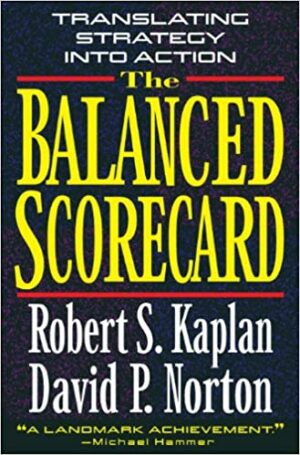 The Balanced Scorecardby Robert S. Kaplan
The Balanced Scorecardby Robert S. Kaplan I think Jim Benson’s review says it well:
“This is the most important boring book I’ve ever read.”
Overall, the insights and case studies are helpful—it’s just dry, long-winded, and a real slog to read through.
What Is the Balanced Scorecard?
- “The Balanced Scorecard provides executives with a comprehensive framework that translates a company’s vision and strategy into a coherent set of performance measures.”
- “The objectives and measures view organizational performance from four perspectives: financial, customer, internal business process, and learning and growth.”
- “The measures are balanced between the outcome measures—the results from past efforts—and the measures that drive future performance. And the scorecard is balanced between objective, easily quantified outcome measures and subjective, somewhat judgmental, performance drivers of the outcome measures.”
The Four Balanced Perspectives:
- Financial: To succeed financially, how should we appear to our shareholders? (E.g., return-on-investment, economic value-added, profitability, revenue growth/mix, cost reduction productivity.)
- Customer: To achieve our vision, how should we appear to our customers? (E.g., market share, customer acquisition, customer retention, customer profitability, customer satisfaction.)
- Internal-Business-Process: To satisfy our shareholders and customers, what business processes must we excel at? (E.g., time, quality, cost, innovation/new product introductions.)
- Learning and Growth: To achieve our vision how will we sustain our ability to change and improve? (E.g., employee satisfaction, employee retention, employee productivity, strategic job coverage, strategic information availability.)
“The four perspectives should be considered a template, not a strait jacket… Depending on industry circumstances and a business unit’s strategy, one or more additional perspectives may be needed.”
What Makes a Good Scorecard?
- “A properly constructed scorecard should tell the story of the business unit’s strategy through such a sequence of cause-and-effect relationships.”
- “A good Balanced Scorecard should have an appropriate mix of outcomes (lagging indicators) and performance drivers (leading indicators) that have been customized to the business units strategy.”
- “The scorecard obtains the benefits from keeping financial measurements as ultimate outcomes, without the myopia and distortions that come from an exclusive focus on improving short-term financial measures.”
- “The art of defining measures for a scorecard rests with the performance drivers. These are the measures that make things happen, that enable the core outcome measures to be achieved.”
- “The metaphor should be a flight simulator, not a dashboard of instrument dials. Like a flight simulator, the scorecard should incorporate the complex set of cause-and-effect relationships among the critical variables, including leads, lags, and feedback loops, that describe the trajectory, the flight plan, of the strategy. The linkages should incorporate both cause-and- effect relationships, and mixtures of outcome measures and performance drivers.”
- “Most important, a Balanced Scorecard should not be created by emulating the best measures used by the best companies.” … “We stress… the importance of incorporating measures that are specifically derived from an organization’s strategy.”
- “Balanced Scorecards are not immutable. They are dynamic and should be continually reviewed, assessed, and updated to reflect new competitive, market, and technological conditions.”
Outcomes vs Performance Drivers / Lagging vs Leading Indicators:
- “All Balanced Scorecards use certain generic measures. These generic measures tend to be core outcome measures, which reflect the common goals of many strategies, as well as similar structures across industries and companies.”
- “Generic outcome measures tend to be lag indicators, such as profitability, market share, customer satisfaction, customer retention, and employee skills.”
- “Performance drivers, the lead indicators, are the ones that tend to be unique for a particular business unit. The performance drivers reflect the uniqueness of the business unit’s strategy.” … “[Drivers] are derived from an explicit and rigorous translation of the organization’s strategy into tangible objectives and measures.”
- “Outcome measures without performance drivers do not communicate how the outcomes are to be achieved. They also do not provide an early indication about whether the strategy is being implemented successfully.”
- “Conversely, performance drivers… without outcome measures may enable the business unit to achieve short-term operational improvements, but will fail to reveal whether the operational improvements have been translated into… enhanced financial performance.”
Should Financial Measures Be Scrapped?
- “Several critics have advocated scrapping financial measures entirely to measure business unit performance. They argue that in today’s technologically and customer-driven global competition, financial measures provide poor guidelines for success.”
- However… “improved financial results are not an automatic outcome of operational improvement programs to improve quality and reduce cycle times… Not all long-term strategies are profitable strategies.”
- “A comprehensive system of measurement and management must specify how improvements in operations, customer service, and new products and services link to improved financial performance.”
- “A failure to convert improved operational performance into improved financial performance should send executives back to the drawing board to rethink the company’s strategy or its implementation plans.”
Diagnostic vs Strategic Measures:
- Diagnostic Measures: Measures that monitor whether the business remains in control and can signal when unusual events are occurring that require immediate attention.
- Strategic Measures: Measures that define a strategy designed for competitive excellence.
“Corporations should have hundreds, perhaps thousands, of [diagnostic] measures that they can monitor to ensure that they are functioning as expected, and to signal when corrective action must be taken. But these are not the drivers of competitive success. Such measures capture the necessary ‘hygiene factors’ that enable the company to operate. These measures should be monitored diagnostically, with deviations from expectations noted rapidly; in effect, management by exception.”
How Bad Things Happen to Good Measures / Using Diagnostic Measures to Balance Strategic Measures
- “Even the best objectives and measures can be achieved in bad ways… If too much pressure is placed on a single customer metric like OTD, managers could soon develop dysfunctional methods to achieve excellent OTD.”
- “A company’s total measurement system should not encourage suboptimization along any single measure or perspective. Designers should attempt to anticipate the suboptimization that might occur for a given metric on the Balanced Scorecard, and provide supplemental metrics that discourage achieving the primary scorecard objective in undesirable ways.”
- “Rather than clutter up the scorecard with additional, nonstrategic measures, companies can use diagnostic measures to balance the strategic measures on the scorecard.”
- For example, Analog Devices… “wanted to offset the temptation to achieve high OTD through long-lead-time quotes… [Using] off-scorecard diagnostic measures like inventory turns and the difference between customer requested delivery dates and quoted delivery dates [enabled] managers to detect when improved on-time delivery performance [was] achieved by undesirable actions.”
Customer Satisfaction vs Profitability:
- “Succeeding in the first four core customer measures of share, retention, acquisition, and satisfaction, however, does not guarantee that a company has profitable customers. Obviously, one way to have extremely satisfied customers (and angry competitors) is to sell products and services at very low prices.”
- “Not all customer demands can be satisfied in ways that are profitable to an organization. Particularly difficult or demanding services may require that the unit either decline the business or else seek price increases that will compensate it for the resources that must be deployed to satisfy that customer’s demand.”
- Balancing customer satisfaction and profitability… “enables [the company] to see where key processes that deliver the product or service to the customer can be reengineered or redesigned so that customers’ demands can be met and the company can still be profitable.”
Measurements as Markers:
- “Generic measures do identify gaps in organizational capabilities, and also serve as markers until managers and employees can develop more customized and specific measures.”
- “Substitute text when measurements are undeveloped or unavailable.”
- For example… “write a one- to two-page memorandum describing, as best they can, the actions taken during the most recent period, the outcomes achieved, and the current state of the organization’s human resource capabilities.”
- “While not the same as measurement, and not a long-term substitute for measurement, the text is a marker that serves many of the same objectives as a formal measurement system. It motivates action in intended directions… It provides a tangible basis for periodic accountability, review, feedback, and learning. And the report serves as a signal that a gap in measurement exists. The signal reminds executives… to develop a system of measurement that provides a more tangible basis for communicating and evaluating objectives.”
Barriers to Effective Strategy Implementation:
- Visions and strategies that are not actionable.
- Strategies that are not linked to departmental, team, and individual goals.
- Strategies that are not linked to long- and short-term resource allocation.
- Feedback that is tactical, not strategic. (I.e., focusing outcomes but not impact, on details instead of solutions.)
-
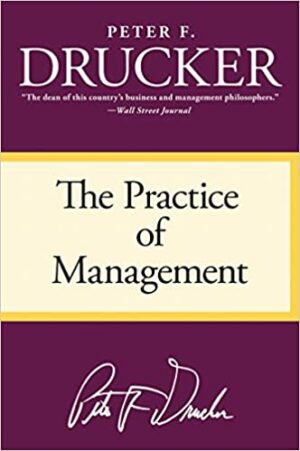 The Practice of Managementby Peter F. Drucker
The Practice of Managementby Peter F. Drucker A treasure trove of advice. Fundamental, comprehensive, timeless.
“The most common source of mistakes in management decisions is the emphasis on finding the right answer rather than the right question… For there are few things as useless—if not as dangerous—as the right answer to the wrong question.”
What Is Management?
- “Management… is a practice, rather than a science or a profession, though containing elements of both.”
- “Management’s first job is managing a business.”
- “The ultimate test of management is business performance.”
- “The essence of business enterprise, the vital principle that determines its nature, is economic performance.”
- “To obtain economic performance there must be an enterprise. Management’s second function is therefore to make a productive enterprise out of human and material resources.”
- “The final function of management is to manage workers and work. Work has to be performed; and the resource to perform it with is workers… This implies organization of the work so as to make it most suitable for human beings, and organization of people so as to make them work most productively and effectively.”
What Are the Basic Operations of a Manager?
- Sets objectives.
- Organizes.
- Motivates and communicates.
- Develops people.
“The manager has a specific tool: information. He does not ‘handle’ people; he motivates, guides, organizes people to do their own work. His tool—his only tool—to do all this is the spoken or written word or the language of numbers.”
“The function which distinguishes the manager above all others is his educational one. The one contribution he is uniquely expected to make is to give others vision and ability to perform. It is vision and moral responsibility that, in the last analysis, define the manager.”
“Management is not concerned with knowledge for its own sake; it is concerned with performance.”
What Is a Business?
- “There is only one valid definition of business purpose: to create a customer.”
- “A business cannot be defined or explained in terms of profit… Profit is not the explanation, cause or rationale of business behavior and business decisions, but the test of their validity.”
- “What is our business is not determined by the producer but by the consumer. It is not defined by the company’s name, statutes or articles of incorporation but by the want the consumer satisfies when he buys a product or a service.”
- “It is the customer who determines what a business is. For it is the customer, and he alone, who through being willing to pay for a good or for a service, converts economic resources into wealth, things into goods. What the business thinks it produces is not of first importance—especially not to the future of the business and to its success. What the customer thinks he is buying, what he considers ‘value,’ is decisive—it determines what a business is, what it produces and whether it will prosper.”
Jobs to Be Done:
- “The Cadillac people say that they make an automobile and their business is the Cadillac Motor Division of General Motors. But does the man who spends four thousand dollars on a new Cadillac buy transportation or does he buy primarily prestige? Does the Cadillac, in other words, compete with the Chevrolet and the Ford; or does it compete—to take an extreme example—with diamonds and mink coats?”
- “The manufacturer of gas kitchen stoves used to consider himself in competition only with the other manufacturers of gas stoves. But the housewife, his customer, does not buy a stove: she buys the easiest way to cook food… The gas-stove manufacturer has to consider his business as that of supplying an easy way to cook, his market as the cooking-implement market, his competition as all suppliers of acceptable ways of cooking food.”
- “‘Competition’ must always be defined according to the customer’s concept of what product or service he buys and must include indirect as well as direct competition.”
“Management still has to ask: ‘Are we in the right business or should we change our business?’”
Profit:
- “It is the first duty of a business to survive. The guiding principle of business economics, in other words, is not the maximization of profits; it is the avoidance of loss. Business enterprise must produce the premium to cover the risks inevitably involved in its operation. And there is only one source for this risk premium: profits.”
- “The problem of any business is not the maximization of profit but the achievement of sufficient profit to cover the risks of economic activity and thus to avoid loss.”
- “The profit motive and its offspring, maximization of profits, are just as irrelevant to the function of a business, the purpose of a business and the job of managing a business. In fact, the concept is worse than irrelevant. It does harm.”
- “Profit is not a cause. It is the result—the result of the performance of the business in marketing, innovation and productivity.”
“By itself, volume of sales tells little about performance, results or the future of the business. A company’s sales may go up—and the company may actually be headed for rapid collapse. A company’s sales may go down—and the reason may not be that its marketing is poor but that it is in a dying field and had better change fast.”
The Tyranny of Metrics:
- “To manage a business is to balance a variety of needs and goals. This requires judgment. The search for the one objective is essentially a search for a magic formula that will make judgment unnecessary.”
- “The measurement used determines what one pays attention to. It makes things visible and tangible. The things included in the measurement become relevant; the things omitted are out of sight and out of mind.”
- “To emphasize only profit, for instance, misdirects managers to the point where they may endanger the survival of the business. To obtain profit today they tend to undermine the future.”
- “Reports and procedures are necessary tools. But few tools can be so easily misused, and few can do as much damage. For reports and procedures, when misused, cease to be tools and become malignant masters.”
- “Reports and procedures should be kept to a minimum, and used only when they save time and labor. They should be as simple as possible.”
- “Every business should regularly find out whether it needs all the reports and procedures it uses. At least once every five years every form should be put on trial for its life.”
Managing People:
- “Managing a business always comes back to the human element—no matter how sound the business economics, how careful the analysis, how good the tools.”
- “The human being has one set of qualities possessed by no other resource: it has the ability to co-ordinate, to integrate, to judge and to imagine.”
- “Man’s specific contribution is always to perform many motions, to integrate, to balance, to control, to measure, to judge.”
- “For development is always self-development. Nothing could be more absurd than for the enterprise to assume responsibility for the development of a man.”
- “It is a peculiarity of man that he yields best to high demands, that, indeed, his capacity to produce is largely determined by the level of the demands made on it.”
- “In all matters of the spirit determination and desire to improve are perhaps even more important than the actual level of performance; dynamic growth is more productive than static perfection.”
- “While man can learn amazingly fast, his unlearning capacity is much lower… The more one has learned the more difficult is unlearning… The need to train workers in the ability to unlearn and to learn will become greater as the skill and knowledge level of the worker increases.”
- “The difference between jobs of a lower order and those of a higher order, between low-paid and high-paid jobs should lie in the ratio of routine, repetitive chores to work requiring skill or judgment. It should lie in the difference between the degree of skill and judgment required.”
“We hear a great deal today about ‘giving’ people pride in their work and a sense of importance or accomplishment. Pride and accomplishment cannot be given. People cannot be made to ‘feel’ important… People are proud if they have done something to be proud of… They feel important if their work is important. The only basis for genuine pride, accomplishment and importance is the active and responsible participation of people in the determination of their own work and in the government of their own plant community.”
Managing Teams:
- “Mutual understanding can never be attained by ‘communications down,’ can never be created by talking. It can result only from ‘communications up.’”
- “A decision should always be made at the lowest possible level and as close to the scene of action as possible. Moreover, a decision should always be made at a level insuring that all activities and objectives affected are fully considered.”
- “Teams should normally not exceed five or six in number; and they work best, as a rule, if they have three or four members.”
- “Size vitally affects the structure of management. Different size demands different behavior and attitudes from the organs of management. And even more influential than size is change in size, that is, growth… Growth always requires new and different competence in top management.”
- “Though managers are individuals, they have to work together in a team, and such an organized group always has a distinct character. Though made by individuals, their vision, their practices, their attitudes, and behavior, this character is a common character. It survives long after the men are gone who originally created it. It molds the behavior and attitudes of newcomers. It decides largely who will succeed in the organization.”
Other Quotes:
- “An instrument panel is no better than the pilot’s ability to read and interpret it.”
- “A conductor must always hear both the whole orchestra and the second oboe.”
- “It is the mark of a good surgeon that he does not cut unless necessary.”
- “One cannot buy loyalty; one can only earn it.”
- “Production is not the application of tools to materials. It is the application of logic to work.”
- “There is nothing less productive than the attempt to cram more productive effort into time than it will comfortably hold.”
- “From the peak there is only one easy way to go: downwards. It always requires twice as much effort and skill to stay up as it did to climb up.”
- “Any fool can learn to stay within his budget. But I have seen only a handful of managers in my life who can draw up a budget that is worth staying within.” —Nicholas Dreystadt
- “It’s easy enough to find a Minister of Education; all the job needs is a long white beard. But a good cook is different; that requires universal genius.” —Bismarck
-
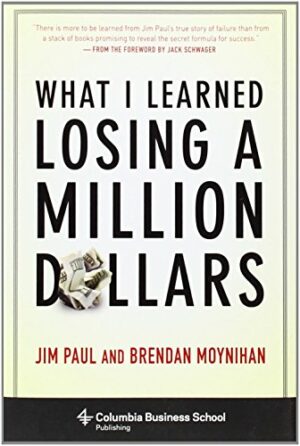 What I Learned Losing a Million Dollarsby Jim Paul
What I Learned Losing a Million Dollarsby Jim Paul Jim Paul’s invaluable life lessons. From the highest highs to the lowest lows, Jim shares how he won it all, lost it all, and found his way back—and how we can avoid the same fate.
- “Learning how not to lose money is more important than learning how to make money.”
- “There are as many ways to make money in the markets as there are people in the markets, but there are relatively few ways to lose money.”
- “Most people who think they are investing are speculating. And most people who think they are speculating are gambling.” —Unknown
“To repeat the leitmotiv of the book thus far: people lose (really lose, not just have occasional losing trades) because of psychological factors, not analytical ones (chapter 5). They personalize the market and their positions (chapter 1 through 4), internalizing what should be external losses (chapter 6), confusing the different types of risk activities (chapter 7), and making crowd trades (chapter 8).”
How to Lose a Million Dollars:
- Personalize the market and your position.
- Internalize external losses.
- Confuse the different types of risk activities (investing, trading, speculating, betting, and gambling).
- Make crowd trades (i.e., emotional decision making).
How Do the Pros Make Money?
- “The pros could all make money in contradictory ways because they all knew how to control their losses… The pros consider it their primary responsibility not to lose money.”
- “Losses per se don’t bother them; unexpected losses and losing on balance does.”
- “All you can do is manage your exposure and losses, not predict profits.”
Loss and Risk:
- “Loss is not the same as wrong, and loss is not necessarily bad.”
- “Decision making is not a choice between right and wrong. In 20/20 hindsight, decisions might be good or bad but not right or wrong.”
- “Risk is defined as the possibility of suffering a loss. (It’s called probability only if you can assign a numerical value to the likelihood of the loss occurring.)”
- “Managing risk solves a problem and should never be engaged in to feel good, look smart, or be right.”
- “Taking responsibility and taking something personally are two different things.”
- “There is a fine line between perseverance because you think the idea is a good one and perseverance because you think the idea is a good one.”
- “Analysis is simply that: analysis. It doesn’t tell you what to do or when to do it.”
- “When dealing with the risk of the uncertainty of the future, you have three choices: engineering, gambling, or speculating.”
Different Types of Risk Activities:
- Investing: Long-term commitments with an expectation of safety and return.
- Trading: Short-term market making. Aims to stay net flat (neither long/short), extracting money from the bid-ask spread.
- Speculating: Trying to see the future. Calculated, but short-term and riskier than investments. Buying now to resell later for a return.
- Betting: Trying to be right. Uncalculated exposure to risk. More concerned with right/wrong than win/loss.
- Gambling: Betting for entertainment. More about stimulation than right/wrong or win/loss.
“It’s the excitement that’s important in gambling, the way right and wrong are important in betting, the way money is important in investing, trading, and speculating.”
Personalizing Your Position:
“Preoccupation with being right means you’re betting, which personalizes the market and is the root of losses due to psychological factors. Concern yourself with whether you have done your homework to define a set of conditions under which you will enter and exit the market and whether you carry out that plan.”
The Psychological Fallacies of Risk:
- High Gain vs High Probability: Overvaluing wagers with a low probability of a high gain and undervaluing wagers with a relatively high probability of low gain. The best examples are the favorites and the long shots at racetracks.
- Additive vs Multiplicative: Interpreting the probability of successive independent events as additive rather than multiplicative. In other words, people view the chance of throwing a given number on a die to be twice as large with two throws as it is with a single throw like throwing sixes four times in a row in craps and thinking that must mean their chances of throwing a seven next have improved.
- Inevitable vs Independent: Believing that after a run of successes, a failure is mathematically inevitable, and vice versa. This is known as the Monte Carlo fallacy. A person can throw double sixes in craps ten times in a row and not violate any laws of probability because each of the throws is independent of all others.
- Favorable vs Probable: Perceiving the psychological probability of an event as greater than the mathematical probability if the event is favorable and vice versa. For example, the probability of success of drawing the winning ticket in the lottery and the probability of being killed by lightning may both be one in 10,000, yet from a personal viewpoint, buying the winning lottery ticket is considered much more probable than getting hit by lightning.
- Streaks vs Short Runs: Overestimating the frequency of infrequent events and underestimating that of comparatively frequent ones after observing a series of randomly generated events of different kinds with an interest in the frequency with which each kind of event occurs. Thus, they remember the “streaks” in a long series of wins and losses and tend to minimize the number of short-term runs.
- Unusual vs Unlikely: Confusing the occurrence of “unusual” events with the occurrence of low-probability events. For example, the remarkable feature of a bridge hand of thirteen spades is its apparent regularity, not its rarity (all hands are equally probable). As another example, if one holds a number close to the winning number in a lottery, he tends to feel that a terrible bad stroke of misfortune has caused him just to miss the prize.
The Five Stages of Internal Loss:
“Have you ever said to yourself, ‘No way. Is the market really down that far?’ That’s denial. Have you ever gotten mad at the market? Called it a name? Gotten angry at friends or family because of a position? That’s anger. Ever begged the market God to get you back to breakeven so you could get out? That’s bargaining. Has a market loss ever changed your sleep or diet patterns? That’s depression. Ever have a firm liquidate one of your positions? That’s acceptance. Unless you have a plan, your potential loss is unknown and you can count on suffering through the Five Stages, losing more money as you go through each of the stages… You eventually accept the loss, so you might as well set the loss to a predetermined amount.”
The Plan:
“Knowing the amount of loss ahead of time reduces the uncertainty factor to nil because you’ve acknowledged and accepted the amount of the potential loss before it occurs.”
- “Before you decide to get into the market you have to decide where (price) or when (time) or why (new information) you will no longer want the position.”
- “To be effective as a loss-control tool, the plan must be derived by deciding STOP, ENTRY, then PRICE OBJECTIVE.”
- “In contrast to what most people do, your entry point should be a function of the exit point. Once you specify what price or under what circumstances you would no longer want the position, and specify how much money you are willing to lose, then, and only then, can you start thinking about where to enter the market.”
- “Failure to choose a price objective could cost the trader some potential profits… But not having a predetermined stop-loss can, and ultimately will, cost you a lot of money.”
- “The distinguishing factor of ‘the’ recipe is determining the stop loss criteria before deciding whether and where to enter the market.” (Emphasis mine.)
- “After you know where you want to get out of the market, then you can ascertain whether and where you are comfortable getting into the market.”
“Naturally, this procedure will cause you to miss some good trades… However, ‘profitable trades’ that are missed actually cost zero while poor controls (pick the stop later) or no controls (no stop) will sooner or later cost you a lot of money.”
“If you wait until after the position is established to choose your exit point or begin moving the stop to allow more room for losses or alter the fundamental factors you monitor in your decision making, then you (1) internalize the loss because you don’t want to lose face, (2) bet or gamble on the position because you want to be right, and (3) make crowd trades because you’re making emotional decisions. As a result, you will lose considerably more money than you can afford.”
“Remember, we are trying to manage possible scenarios and losses, not predict the future and profits.”
-
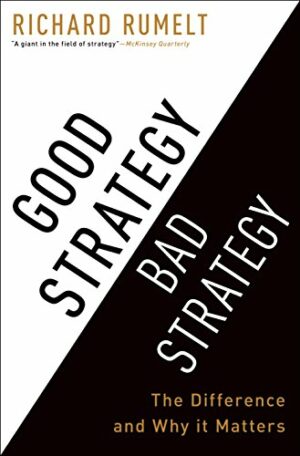 Good Strategy Bad Strategyby Richard P. Rumelt
Good Strategy Bad Strategyby Richard P. Rumelt The first book I ever read twice—so good, I’ll probably read it again.
Thank you, Ernesto Diaz, for giving me this book nearly 10 years ago. It’s made a huge difference in my life and work.
“Nelson’s challenge was that he was outnumbered. His strategy was to risk his lead ships in order to break the coherence of his enemy’s fleet. With coherence lost, he judged, the more experienced English captains would come out on top in the ensuing melee. Good strategy almost always looks this simple and obvious and does not take a thick deck of PowerPoint slides to explain.”
- “The core of strategy work is always the same: discovering the critical factors in a situation and designing a way of coordinating and focusing actions to deal with those factors.”
- “A good strategy does more than urge us forward toward a goal or vision. A good strategy honestly acknowledges the challenges being faced and provides an approach to overcoming them.”
- “A good strategy doesn’t just draw on existing strength; it creates strength through the coherence of its design. Most organizations… pursue multiple objectives that are unconnected with one another or, worse, that conflict with one another.”
- “A great deal of strategy work is trying to figure out what is going on. Not just deciding what to do, but the more fundamental problem of comprehending the situation.”
The Kernel of Good Strategy:
“Good strategy is coherent action backed up by an argument, an effective mixture of thought and action with a basic underlying structure I call the kernel…”
- Diagnosis: A diagnosis defines or explains the nature of the challenge. A good diagnosis simplifies the often overwhelming complexity of reality by identifying certain aspects of the situation as critical.
- Guiding Policy: A guiding policy specifies the approach to dealing with the obstacles called out in the diagnosis. It is like a signpost, marking the direction forward but not defining the details of the trip.
- Coherent Action: Coherent actions are feasible coordinated policies, resource commitments, and actions designed to work together in accomplishing the guiding policy.
“To obtain higher performance, leaders must identify the critical obstacles to forward progress and then develop a coherent approach to overcoming them.”
What Is Bad Strategy?
“Bad strategy… is not the same thing as no strategy or strategy that fails rather than succeeds. Rather, it is an identifiable way of thinking and writing about strategy.”
- Fluff: Fluff is a form of gibberish masquerading as strategic concepts or arguments. It uses “Sunday” words (words that are inflated and unnecessarily abstruse) and apparently esoteric concepts to create the illusion of high-level thinking… Fluff is superficial restatement of the obvious combined with a generous sprinkling of buzzwords.
- Failure to face the challenge: Bad strategy fails to recognize or define the challenge. When you cannot define the challenge, you cannot evaluate a strategy or improve it.
- Mistaking goals for strategy: Many bad strategies are just statements of desire rather than plans for overcoming obstacles.
- Bad strategic objectives: A strategic objective is set by a leader as a means to an end. Strategic objectives are “bad” when they fail to address critical issues or when they are impracticable.
“If you fail to identify and analyze the obstacles, you don’t have a strategy. Instead, you have either a stretch goal, a budget, or a list of things you wish would happen.”
Goals and Objectives:
- “To help clarify this distinction it is helpful to use the word ‘goal’ to express overall values and desires and to use the word ‘objective’ to denote specific operational targets.”
- “Effective senior leaders don’t chase arbitrary goals. Rather, they decide which general goals should be pursued. And they design the subgoals that various pieces of the organization work toward. Indeed, the cutting edge of any strategy is the set of strategic objectives (subgoals) it lays out.”
- “A leader’s most important job is creating and constantly adjusting this strategic bridge between goals and objectives.”
- “What one single feasible objective, when accomplished, would make the biggest difference?”
Diagnosis:
- “In business, most deep strategic changes are brought about by a change in diagnosis—a change in the definition of the company’s situation.”
- “Walton didn’t break the conventional wisdom; he broke the old definition of a store.”
- “At Starbucks, one executive might diagnose this challenging situation as ‘a problem in managing expectations.’ Another might diagnose it as ‘a search for new growth platforms.’ A third might diagnose it as ‘an eroding competitive advantage.’ … Importantly, none of these diagnoses can be proven to be correct—each is a judgment about which issue is preeminent. Hence, diagnosis is a judgment about the meanings of facts.”
Guiding Policy:
- “In the real world… ‘maximize profit’ is not a helpful prescription, because the challenge of making, or maximizing, profit is an ill-structured problem. Even in a corner grocery store, there are hundreds or thousands of possible adjustments one can make, and millions in a business of any size—the complexity of the situation can be overwhelming.”
- “Scanning her list… she determined that there was a choice between serving the more price-conscious students or the more time-sensitive professionals. Transcending thousands of individual choices and instead framing the problem in terms of choosing among a few customer groups provided a dramatic reduction in complexity.”
Advantage:
- “A competitive advantage is interesting when one has insights into ways to increase its value. That means there must be things you can do, on your own, to increase its value.”
- “No one has an advantage at everything. Teams, organizations, and even nations have advantages in certain kinds of rivalry under particular conditions. The secret to using advantage is understanding this particularity. You must press where you have advantages and side-step situations in which you do not. You must exploit your rivals’ weaknesses and avoid leading with your own.”
Limiting Factors:
- “In assessing a property’s potential, one should identify the limiting factors. If a house is near a noisy highway, that is a limiting factor. No matter how much marble is put in the bathrooms or how fine the cabinetry is in the kitchen, the noise will limit the house’s value.”
- “As an investor, one wants to find limiting factors that can be fixed, such as paint, rather than factors that cannot be fixed, such as highway noise.”
- “Increasing the quality of an automobile transmission does little good if the knobs fall off the dashboard and door panels continue to rattle.”
Decentralization vs Centralization:
- “When I say strategy is ‘imposed,’ I mean just that. It is an exercise in centralized power, used to overcome the natural workings of a system. This coordination is unnatural in the sense that it would not occur without the hand of strategy.”
- “The oft-forgotten cost of decentralization is lost coordination across units… Stores that do not share detailed information about what works and what does not cannot benefit from one another’s learning.”
- “On the other hand… Coordination is costly, because it fights against the gains to specialization, the most basic economies in organized activity… Coordination interrupts and de-specializes people. Thus, we should seek coordinated policies only when the gains are very large.”
- “The brilliance of good organization is not in making sure that everything is connected to everything else… Good strategy and good organization lie in specializing on the right activities and imposing only the essential amount of coordination.”
Strategy and Performance:
- “Performance is the joint outcome of capability and clever design… The greater the challenge, the greater the need for a good, coherent, design-type strategy.”
- “With less challenge, it is normally better to have a bit less specialization and integration so that a broader market can be addressed.”
- “Tight integration comes at some cost. That is, one does not always seek the very highest level of integration in a design for a machine or a business. A more tightly integrated design is harder to create, narrower in focus, more fragile in use, and less flexible in responding to change.”
- “A Formula 1 racing car, for example, is a tightly integrated design and is faster around the track than a Subaru Forester, but the less tightly integrated Forester is useful for a much wider range of purposes. Nevertheless, when the competitive challenge is very high, it may be necessary to accept these costs and design a tightly integrated response.”
Identifying Strategy:
“How can we independently identify a company’s strategy? We do this by looking at each policy of the company and noticing those that are different from the norm in the industry. We then try to figure out the common target of such distinctive policies—what they are coordinated on accomplishing.”
Essential Skills for Strategy Work:
- Have a variety of tools for fighting your own myopia and for guiding your own attention. (E.g., the kernel, problem-solution, create-destroy, panel of experts.)
- Develop the ability to question your own judgment. If your reasoning cannot withstand a vigorous attack, your strategy cannot be expected to stand in the face of real competition.
- Cultivate the habit of making and recording judgments so that you can improve.
Other Highlights:
- “Hannibal never lost a battle in Italy, but Carthage lost the war.”
- “Even with its engines on hard reverse, a supertanker can take one mile to come to a stop.”
- “If resources were not limited, there would be no need to select one objective over another.”
- “Healthy growth is not engineered.”
- “This course is labeled ‘advanced’ because we don’t understand it very well… If there were a clear and consistent theory about what is going on here, we would call this course ‘elementary’ physics.”
- “There are lots of sausage-making tools being hawked for strategy work, but good ideas don’t come out of mechanical tools. Conceptual tools may help us get oriented, but, in the end, good ideas basically just pop into our heads. It’s called ‘insight.’”
P.S. How sources of power shifted in computing:
“In the computing and telecommunications equipment sectors, economic success had traditionally been based on capabilities at coordinating hordes of engineers in vast billion-dollar development projects and in managing large workforces in the manufacture of complex electronic equipment. That had been the basis of the power of IBM and AT&T and had been central to the engineering-intensive success of Japan. But now, in 1996, the basis of success in many areas was shifting to software—to the cleverness of chunks of code written by small teams. It was a shift from economies of size to the know-how and skill of single individuals. It was as if military competition suddenly shifted from large armies to single combat. A chill moved up and down my spine. There was the unnerving sense of hidden subterranean forces at work, twisting the landscape.”
-
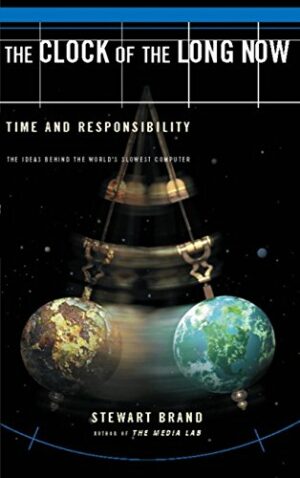 The Clock of the Long Nowby Stewart Brand
The Clock of the Long Nowby Stewart Brand Zooming out, slowing down. Learning to think in terms of a big here and long now.
What Is the Long Now?
- “The Long Now Foundation was established in 1996 to foster long-term responsibility.”
- “How do we make long-term thinking automatic and common instead of difficult and rare? How do we make the taking of long-term responsibility inevitable?”
- “The ambition and folly of the Clock/Library is to reframe human endeavor, and to do so not with a thesis but with a thing. All this thing can do is give permission to think long term. If it succeeds in that, the rest may follow… In a world of hurry the Clock is a patience machine.”
- “Ideally, [the Clock] would do for thinking about time what the photographs of Earth from space have done for thinking about the environment. Such icons reframe the way people think.”
Speeding Up:
- “The pace of Moore’s Law has become the pacesetter for human events. According to a rule of thumb among engineers, any tenfold quantitative change is a qualitative change, a fundamentally new situation rather than a simple extrapolation. Moore’s Law brings such tenfold structural changes every three years or so, thus three revolutions every decade, for five decades straight.”
- “Velocity itself became the dominating characteristic of the world’s quicksilver economy. ‘We are moving from a world in which the big eat the small,’ remarked Klaus Schwab, head of the World Economic Forum, ‘to a world in which the fast eat the slow.’”
- “With technological acceleration driving economic acceleration, politics and culture can only struggle to keep up.”
Progress vs Change:
- “Now that we have progress so rapid that it can be observed from year to year, no one calls it progress. People call it change, and rather than yearn for it, they brace themselves against its force.”
- “People already refer to the near future in months instead of years, and to the distant future in years instead of decades or centuries. What may happen decades from now—beyond the imagined event horizon—is treated as not only unknown but unknowable.”
- “Is compressed time dearer or more disposable? The price per minute is higher, but is the sustainable value? Does intense progress make everything better, or just more temporary?”
Big Here, Long Now:
“During dinner I asked the hostess, ‘Do you like living here?’ ‘Oh sure,’ she replied, ‘this is the loveliest place I’ve ever lived.’ I realized that the ‘here’ she lived in stopped at her front door. This was a very strange thought to me. My ‘here’ includes the neighborhood at least. After that, I noticed that young arty New Yorkers were just as local in their sense of ‘now.’ ‘Now’ meant ‘this week.’ Everyone had just got there, and was just going somewhere else. No one had any investment in any kind of future except their own, conceived in the narrowest terms. I wrote in my notebook that December, ‘More and more I find I want to be living in a Big Here and a Long Now.’” —Brian Eno
How Long Is “Now”?
- “Now is the period in which people feel they live and act and have responsibility. For most of us now is about a week, sometimes a year. For some traditional tribes in the American northeast and Australia now is seven generations back and forward (175 years each direction). Just as the Earth photographs gave us a sense of the big here, we need things that give people a sense of the long now.”
- “On the stock exchange it’s today, on the Net it’s a month, in fashion it’s a season, in demographics a decade, in most companies it’s the next quarter.” —Esther Dyson
- “The sociologist Elise Boulding diagnosed the problem of our times as ‘temporal exhaustion’: ‘If one is mentally out of breath all the time from dealing with the present, there is no energy left for imaging the future.’”
“Eno’s Long Now places us where we belong, neither at the end of history nor at the beginning, but in the thick of it. We are not the culmination of history, and we are not start-over revolutionaries; we are in the middle of civilization’s story.”
Managing Change:
- “How do [civilizations] manage change, and how do they absorb and incorporate shocks? The answer appears to lie in the relationship between components in a system that have different change rates and different scales of size.”
- “Instead of breaking under stress like something brittle these systems yield as if they were malleable. Some parts respond quickly to the shock, allowing slower parts to ignore the shock and maintain their steady duties of system continuity. The combination of fast and slow components makes the system resilient, along with the way the differently paced parts affect each other.”
- “Fast learns, slow remembers. Fast proposes, slow disposes. Fast is discontinuous, slow is continuous. Fast and small instructs slow and big by accrued innovation and occasional revolution. Slow and big controls small and fast by constraint and constancy. Fast gets all our attention, slow has all the power. All durable dynamic systems have this sort of structure; it is what makes them adaptable and robust.”
Levels of Pace and Size in Civilization:
- Fashion/Art
- Commerce
- Infrastructure
- Governance
- Culture
- Nature
“In a healthy society each level is allowed to operate at its own pace, safely sustained by the slower levels below and kept invigorated by the livelier levels above.”
Pace of Change:
- “We should not deplore rapidly changing technology and business while government controls, cultural mores, and so-called wisdom change slowly; that’s their job.”
- “Note that as people get older, their interests tend to migrate to the slower parts of the continuum. Culture is invisible to adolescents but a matter of great concern to elders. Adolescents are obsessed by fashion, elders bored by it.”
Reinventing vs Inventing:
- “Starting anew with a clean slate has been one of the most harmful ideas in history. It treats previous knowledge as an impediment and imagines that only present knowledge deployed in theoretical purity can make real the wondrous new vision.”
- “The accumulated past is life’s best resource for innovation. Revolutions cut off the past. Evolution shamelessly, lazily repurposes the past. Reinventing beats inventing nearly every time.”
The Digital Dark Age:
- “It is only slightly facetious to say that digital information lasts forever—or five years, whichever comes first.” —Jeff Rothenberg
- “Fixing digital discontinuity sounds like exactly the kind of problem that fast-moving computer technology should be able to solve; but it can’t, because fast-moving computer technology is the problem. By constantly accelerating its own capabilities (making faster, cheaper, sharper tools that make ever faster, cheaper, sharper tools) the technology is just as constantly self-obsolescing. The great creator is the great eraser.”
- “Danny Hillis notes that from previous ages we have good raw data written on clay, on stone, on parchment and paper, but from the 1950s to the present recorded information increasingly disappears into a digital gap. Historians will consider this a dark age… Science historians can read Galileo’s technical correspondence from the 1590s but not Marvin Minsky’s from the 1960s.”
- “Not only do file formats quickly become obsolete, the physical media themselves are short lived. Magnetic media such as disks and tape lose their integrity in five to ten years. Optically etched media such as CD-ROMs, if used at all, only last five to fifteen years before they degrade; and digital files do not degrade gracefully like analog audio tapes. When they fail, they fail utterly. You can’t open them. They have one-tenth the readable life span of acid-laced newsprint.”
“We probably cannot and should not reverse the digitization of everything. What we can do is convert the design of software from brittle to resilient, from heedlessly headlong to responsible, and from time corrupted to time embracing.”
Digital Preservation:
- “Loss of cultural memory becomes the price of staying perfectly current.”
- “Digital storage is easy; digital preservation is hard. Preservation means keeping the stored information catalogued, accessible, and usable on current media, which requires constant effort and expense.”
- “In 1998 a major (but unheralded) milestone occurred: Available digital data storage capacity surpassed the total of information in the world. We now have more room to store stuff than there is stuff to store. In other words, concludes Lesk, ‘We will be able to save everything—no information will have to be thrown out—and the typical piece of information will never be looked at by a human being.’”
- “The archivist Howard Besser points out that digital artifacts are increasingly complex to revive. For starters you’ve got the viewing problem: a book displays itself, but the contents of a CD-ROM are invisible until opened on something. Then there’s the scrambling problem: the innumerable ways in which files are compressed and, increasingly, encrypted. There are interrelationship problems: hypertext or web-site links active in the original that now are dead ends. And translation problems occur in the way different media behave: Just as a photograph of a painting is not the same experience as the painting, looking through a screen is not the same as experiencing an immersion medium; watching a game is not the same as playing the game.”
“Is the Net itself profoundly robust and immortal, or is it the most ephemeral digital artifact of all?”
Tragic Optimism:
“Paul Saffo says that in the short term the pessimists are right, and in the long term the optimists are right. Everything has been going to hell as long as anyone can remember… So, short term worse, long term better. Maybe the way to resolve them is tragic optimism. I would settle for a world of tragic optimists.”
Science Fiction and Scenario Planning:
- “‘Economic forecasting misses the real future because it has too short a range; fiction misses the future because it has too little imagination.’ Too little imagination? Yes, for a structural reason almost never taken into account. At any time the several ‘probable’ things that might occur in the future are vastly outnumbered by the countless near-impossible eventualities, which are so many and individually so unlikely that it is not worth the effort of futurists or futurismists to examine and prepare for even a fraction of them. Yet one of those innumerable near-impossibilities is what is most likely to occur. Reality is thus statistically forced always to be extraordinary. Fiction is not allowed that freedom. Fiction has to be plausible; reality doesn’t.”
- “One surprising by-product of the scenario-planning process is increased responsibility. Corporations discover the need to take care of their industry as a whole, or to protect the natural environment, or to promote civil liberties. This comes not from virtue but solely from the ability to engage longer periods of time. While twenty-year forecasts are a complete waste of effort, twenty-year scenarios are common and useful.”
- “Believing in the future is not the same as believing you can predict it or determine it. The Long Now Foundation is not about determining the destiny of our descendants, it is about leaving them with a chance to determine a destiny of their own.”
Extending the Shadow of the Future:
- “To produce the benefits of more cooperation in the world, Axelrod proves, all you need to do is lengthen the shadow of the future—that is, ensure more durable relationships.”
Solving Problems:
- “When a manager comes to me, I don’t ask him, ‘What’s the problem?’ I say, ‘Tell me the story.’ That way I find out what the problem really is.” —Avram Goldberg
- “When a design problem resists solution, reframe the problem in such a way that it invites solution.”
Learning and Unlearning:
- “Feedback is the primary tool for tuning systems, especially at the natural/artificial interface.”
- “As history accelerates, people become fast learners, and that’s good, but it is also a problem.”
- “Fast learners tend to track noisy signals too closely and to confuse themselves by making changes before the effects of previous actions are clear.” —James March
- “The slow stuff is the serious stuff, but it is invisible to us quick learners. Our senses and our thinking habits are tuned to what is sudden, and oblivious to anything gradual.”
- “In a sense, the task here is to make the world safe for hurry by slowing some parts way down.”
Life Expectancy:
- “Never in history have so many generations been alive at the same time.”
- “With safer childbirth and improvements in medicine, a newborn’s life expectancy reached thirty-four in 01900, forty-six in 01954, and sixty-four in 01998. Even without a medical breakthrough it is expected to be seventy-two by 02020. In one lifetime life expectancy has increased 50 percent… In one century elders have gone from being rare and honored to common and powerful.”
Infinite Games:
- “Finite games… require fixed rules so that the winner and loser are determined fairly, but infinite games thrive on occasional changes in the rules—agreed to by the players—so that the game constantly improves.”
- “Finite games focus on how they end, while infinite games focus on how they continue.”
- “You can always improve things as long as you’re prepared to wait.”
Fast and Slow:
- “Earthquakes, war, murder, the burning of libraries… bad things happen fast. Reforestation, the growth of a child, the maturing of an adult, building a library… good things happen slow.”
- “There are two ways to make systems fault-tolerant: One is to make them small, so that correction is local and quick; the other is to make them slow, so that correction has time to permeate the system.”
- “Gradually emergent processes get steadily better over time, while quickly imposed processes often get worse over time.”
- “The kinds of goals that can be reached quickly are rather limited, and work on them displaces attention and effort that might be spent on worthier, longer-term goals.”
- “Can anyone eat lobster without making a mess? … A brain surgeon at the table did it. It took him two hours—a completely eaten lobster with a perfect absence of mess. He took the time appropriate to the job, which he knew about. It wasn’t his skill. It was his patience.” —Seymour Papert
Other Highlights:
- “Think globally, act locally.” —René Dubos
- “Zen Buddhists define their task as ‘infinite gratitude for the past. Infinite service to the present. Infinite responsibility to the future.’”
- “The ultimate reason for initiating something ambitious is not to fulfill certain notions but to find out what surprises might emerge.”
- “First answers usually are knee-jerk. Second answers tend to be cute. Third answers to the same question sometimes tell the truth.”
- “Two hundred years is too readily imaginable, too incremental. Frames of mind change by jumps, not by degrees.”
- “Live like you’ll die tomorrow. Farm like you’ll live forever.” —John Marsden
- “Exercise is the best preserver.”
- “Rather than make detailed, brittle plans for the future, wisdom puts its effort into expanding general, adaptive options.”
- “I must study politics and war that my sons may have liberty to study mathematics and philosophy.” —John Adams
- “Surprise plus memory equals learning. Endless surprise, diligent memory, endless learning.”
-
 The Use of Lateral Thinkingby Edward de Bono
The Use of Lateral Thinkingby Edward de Bono Brilliant. The book that coined the term lateral thinking.
Honestly, the book is best read and experienced, not just summarized or quoted. You have to feel the change in thinking. So I’ll simply quote the introduction…
The Pebble Story:
“Many years ago when a person who owed money could be thrown into jail, a merchant in London had the misfortune to owe a huge sum to a money-lender. The money-lender, who was old and ugly, fancied the merchant’s beautiful teenage daughter. He proposed a bargain. He said he would cancel the merchant’s debt if he could have the girl instead.
Both the merchant and his daughter were horrified at the proposal. So the cunning money-lender proposed that they let Providence decide the matter. He told them that he would put a black pebble and a white pebble into an empty money-bag and then the girl would have to pick out one of the pebbles. If she chose the black pebble she would become his wife and her father’s debt would be cancelled. If she chose the white pebble she would stay with her father and the debt would still be cancelled. But if she refused to pick out a pebble her father would be thrown into jail and she would starve.
Reluctantly the merchant agreed. They were standing on a pebble-strewn path in the merchant’s garden as they talked and the money-lender stooped down to pick up the two pebbles. As he picked up the pebbles the girl, sharp-eyed with fright, noticed that he picked up two black pebbles and put them into the money-bag. He then asked the girl to pick out the pebble that was to decide her fate and that of her father.
Imagine that you are standing on that path in the merchant’s garden. What would you have done if you had been the unfortunate girl? If you had had to advise her what would you have advised her to do?
What type of thinking would you use to solve the problem? You may believe that careful logical analysis must solve the problem if there is a solution. This type of thinking is straight-forward vertical thinking. The other type of thinking is lateral thinking.
Vertical thinkers are not usually of much help to a girl in this situation. The way they analyse it, there are three possibilities:
- The girl should refuse to take a pebble.
- The girl should show that there are two black pebbles in the bag and expose the money-lender as a cheat.
- The girl should take a black pebble and sacrifice herself in order to save her father from prison.
None of the suggestions is very helpful, for if the girl does not take a pebble her father goes to prison, and if she does take a pebble, then she has to marry the money-lender.
The story shows the difference between vertical thinking and lateral thinking. Vertical thinkers are concerned with the fact that the girl has to take a pebble. Lateral thinkers become concerned with the pebble that is left behind. Vertical thinkers take the most reasonable view of a situation and then proceed logically and carefully to work it out. Lateral thinkers tend to explore all the different ways of looking at something, rather than accepting the most promising and proceeding from that.”
Scroll down to see how the girl escapes…
What Is “Lateral” Thinking?
“The terms ‘lateral’ and ‘vertical’ were suggested by the following considerations.
It is not possible to dig a hole in a different place by digging the same hole deeper.
Logic is the tool that is used to dig holes deeper and bigger, to make them altogether better holes. But if the hole is in the wrong place, then no amount of improvement is going to put it in the right place. No matter how obvious this may seem to every digger, it is still easier to go on digging in the same hole than to start all over again in a new place. Vertical thinking is digging the same hole deeper; lateral thinking is trying again elsewhere.”
Principles of Lateral Thinking:
- Recognition of dominant polarizing ideas.
- The search for different ways of looking at things.
- A relaxation of the rigid control of vertical thinking.
- The use of chance.
Book Chapters:
- Chapter 1. The difference between vertical thinking as high-probability, straight-ahead thinking, and lateral thinking as low-probability, sideways thinking.
- Chapter 2. The way ideas do not, unfortunately, come about through sheer vertical effort.
- Chapter 3. The polarizing effect of dominant ideas.
- Chapter 4. A visual exercise in thinking.
- Chapter 5. The deliberate search for the many different ways of looking at something.
- Chapter 6. The arrogance of vertical thinking that prevents the emergence of new ideas.
- Chapter 7. The use of chance by acknowledging its value, not interfering, encouraging chance processes, and harvesting the outcome.
- Chapter 8. Illustrations of the practical use of one aspect of lateral thinking.
- Chapter 9. The disadvantages of doing without lateral thinking.
- Chapter 10. The exploitation of lateral thinking and the use of new ideas.
Dominant Ideas:
How does one escape from the influence of dominating ideas?
- Expose the Dominating Idea: “A useful technique of lateral thinking is to pick out very deliberately, to define and even write down the idea that seems to be dominating the situation. Once an idea has been exposed in this way it becomes easier to recognize and therefore avoid its polarizing influence. It seems obvious and easy to do, but the exposure must be careful and deliberate; a general vague consciousness of the dominant idea is of no use at all.”
- Distort the Dominating Idea: “Another technique is to acknowledge the dominant idea and then gradually distort it until in the end it loses its identity and collapses. The distortion may simply involve carrying the idea to extremes, or it may involve the exaggeration of only one feature. Once again, the process must be quite deliberate and self-conscious.”
- Avoid Simple Rejection: “It might seem easier to identify the dominant idea and then vigorously to reject it. But rejection is only exchanging positive domination for negative domination, and instead of weakening the dominant idea it may even strengthen it. Moreover, freedom of thought is just as limited by rejection of an idea as by acceptance of that idea.”
- Explore the Wrong Answer: “It is sometimes a useful technique to try to be deliberately wrong in the evaluation of an idea. Instead of rapidly rejecting an idea which seems logically absurd, one accepts it and from it proceeds as far as one can in each direction—that is, downwards, to find its supports, and upwards, to see what it would lead to. This is much more difficult than it seems, and requires a good deal of practice. The purpose of such perversity is to question the accepted point of view on which was built the original logical rejection. In defending an apparently incorrect idea, a better point of view can often be discovered.”
See also: avoiding the rigidity of words, reversing relationships, transferring the relationships to a different situation, and shifting emphasis to a different part of the problem.
The Use of Play:
“Playing around is an experiment with chance. It is by no means easy to play in this fashion, for deliberate and earnest efforts at play defeat its purpose. The very uselessness of play is its greatest asset. It is this freedom from design or commitment that allows chance to juxtapose things which would not otherwise have been arranged in this way, to construct a sequence of events which would not otherwise have been constructed. The apparent uselessness of play naturally discourages people from playing. Vertical thinkers are ashamed to play, but the only shameful thing is the inability to play.”
Other Highlights:
- “The path to new ideas is blocked by false assumptions.”
- “When an idea is not ready, logical strictness will not mature it faster.”
- “More often the danger is not one of over-awareness of an idea, but of neglect of ways of looking at things that are blotted out by a dominant idea.”
- “No amount of excellence on the part of an electronic computer can lead to the solution of a problem if the problem has been incorrectly defined by the programmer.”
- “Pouncing on an idea as soon as it appears kills the idea. Too early and too enthusiastic logical attention either freezes the idea or forces it into the old moulds. Concentration on an idea isolates it from its surroundings and arrests its growth. The glare of attention inhibits the fertile semi-conscious processes that go to develop an idea.”
- “A mind which has too few new ideas can be excused an eagerness to rush at them: but in general an idea is far more fertile if seduced rather than raped.”
- “It is better to have enough ideas for some of them to be wrong than to be always right by having no ideas at all.”
How the Girl Escapes:
“The girl in the pebble story put her hand into the money bag and drew out a pebble. Without looking at it she fumbled and let it fall to the path where it was immediately lost among all the others.
‘Oh, how clumsy of me,’ she said, ‘but never mind—if you look into the bag you will be able to tell which pebble I took by the colour of the one that is left.’
Since the remaining pebble is of course black, it must be assumed that she has taken the white pebble, since the money-lender dare not admit his dishonesty. In this way, by using lateral thinking, the girl changes what seems an impossible situation into an extremely advantageous one. The girl is actually better off than if the money-lender had been honest and had put one black and one white pebble into the bag, for then she would have had only an even chance of being saved. As it is, she is sure of remaining with her father and at the same time having his debt cancelled.”
-
 Simple Sabotage Field Manualby United States Office of Strategic Services
Simple Sabotage Field Manualby United States Office of Strategic Services Mentioned in Ruined by Design, this brief manual from WWII taught ordinary people how to sabotage their workplace in Axis-controlled countries.
Quick, interesting—kind of wild to see how spot-on the General Interference with Organizations and Production section is. It’s basically a textbook on how to be a terrible person to work with.
- “Simple sabotage is more than malicious mischief, and it should always consist of acts whose results will be detrimental to the materials and manpower of the enemy.”
- “Simple sabotage does not require specially prepared tools or equipment; it is executed by an ordinary citizen… and it is carried out in such a way as to involve a minimum danger of injury, detection, and reprisal.”
- “Acts of simple sabotage, multiplied by thousands of citizen-saboteurs, can be an effective weapon against the enemy. Slashing tires, draining fuel tanks, starting fires, starting arguments, acting stupidly, short-circuiting electric systems, abrading machine parts will waste materials, manpower, and time.”
Know Your Limits:
“The saboteur should never attack targets beyond his capacity or the capacity of his instruments. An inexperienced person should not, for example, attempt to use explosives, but should confine himself to the use of matches or other familiar weapons.”
Choosing Targets:
- “The saboteur should try to damage only objects and materials known to be in use by the enemy or to be destined for early use by the enemy.”
- “Slashing a rubber tire on an Army truck may be an act of value; spoiling a batch of rubber in the production plant is an act of still more value.”
Causing Trouble:
- “A clean factory is not susceptible to fire, but a dirty one is. Workers should be careless with refuse and janitors should be inefficient in cleaning. If enough dirt and trash can be accumulated an otherwise fireproof building will become inflammable.”
- “Saturate a sponge with a thick starch or sugar solution. Squeeze it tightly into a ball, wrap it with string, and dry. Remove the string when fully dried. The sponge will be in the form of a tight hard ball. Flush down a W. C. or otherwise introduce into a sewer line. The sponge will gradually expand to its normal size and plug the sewage system.”
Getting Away With It:
“Always be profuse in your apologies. Frequently you can ‘get away’ with such acts under the cover of pretending stupidity, ignorance, over-caution, fear of being suspected of sabotage, or weakness and dullness due to undernourishment.”
How to Be a Terrible Person to Work With:
- “Insist on doing everything through ‘channels.’ Never permit short-cuts to be taken in order to expedite decisions.”
- “Talk as frequently as possible and at great length. Illustrate your ‘points’ by long anecdotes and accounts of personal experiences.”
- “Refer all matters to committees, for ‘further study and consideration.’ Attempt to make the committees as large as possible—never less than five.”
- “Insist on perfect work in relatively unimportant products; send back for refinishing those which have the least flaw. Approve other defective parts whose flaws are not visible to the naked eye.”
- “Never pass on your skill and experience to a new or less skillful worker.”
- “Give lengthy and incomprehensible explanations when questioned.”
- “Act stupid.”
- “Be as irritable and quarrelsome as possible without getting yourself into trouble.”
Music
Here’s a list of the albums, artists, and playlists I listened to most this year, in the order I first listened to them.
-
 Integrity Bluesby Jimmy Eat World
Integrity Bluesby Jimmy Eat World Emo revival. On loop.
-
 What Kinda Musicby Tom Misch & Yussef Dayes
What Kinda Musicby Tom Misch & Yussef Dayes Surreal jazz. Drums for days.
-
 lofi beatsby Various Artists
lofi beatsby Various Artists Go-to think playlist. Late night grooves.
-
 Mutemathby Mutemath
Mutemathby Mutemath
-
 Play Deadby Mutemath
Play Deadby Mutemath Electronic rock ‘n’ roll. Solid jams. (Don’t forget Vitals!)
-
 Imbueby The Early November
Imbueby The Early November Solid alternative rock.
-
 Ixoraby Copeland
Ixoraby Copeland Melodic rock returns. Dreamy, comforting.
-
 In Motionby Copeland
In Motionby Copeland Indie rock love stories. On loop.
-
 You Are My Sunshineby Copeland
You Are My Sunshineby Copeland My first Copeland album. Sentimental.
-
 Give One Take Oneby ’68
Give One Take Oneby ’68 Noise perfection. (Bad Bite, oh my God…)
-
 One Wingby The Chariot
One Wingby The Chariot “Let’s get weird.”
-
 Long Live (10 Year Anniversary)by The Chariot
Long Live (10 Year Anniversary)by The Chariot Raw, brutal, flawless. “This is only a revolt.”
-
 How Do You Feel Now?by Joywave
How Do You Feel Now?by Joywave Eclectic electric rock. Marvelous.
-
 Fingertipsby Vera Blue
Fingertipsby Vera Blue Haunting folk electronica.
-
 Perennialby Vera Blue
Perennialby Vera Blue Folktronica returns, bigger and better.
-
 What Nowby Sylvan Esso
What Nowby Sylvan Esso Electronic pop freedom. On loop.
-
 Free Loveby Sylvan Esso
Free Loveby Sylvan Esso “Pandemic pop”. Subtle, fantastic.
-
 Sjowgrenby Sjowgren
Sjowgrenby Sjowgren Feel-good indie. Nostalgic singles for days.
-
 SUPERBLOOMby MisterWives
SUPERBLOOMby MisterWives Soaring, pumping, healing. A COVID anthem.
-
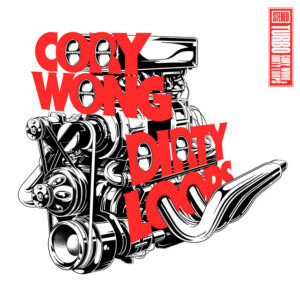 Turboby Cory Wong
Turboby Cory Wong Funk on steroids. Let’s go.
-
 An Evening With Silk Sonicby Silk Sonic
An Evening With Silk Sonicby Silk Sonic R&B time warp. Smooth, easy fun.
Code
To close, here’s a collection of code stuff I did this year.
Tools
- 📊 Snap Slider – Performance Measurements
- 🙈 Snap Slider “Hide Scrollbars” Example
- 🔥 Snap Slider – Fix iOS 15 Scroll Jank
- 🚧 Snap Slider V3 (work in progress)
- 🐦 Twitter Print Styles – Firefox Extension
- 🧭 GitHub Wiki Search – Safari Extension
- 👨🔧 WordPress PHPUnit Tests
Videos
Core Web Vitals
- 🏥 Confirmed that Chrome 89 fixed opacity affecting CLS
- 🏥 Confirmed that Chrome 94 fixed opacity affecting FCP
- 🐛 CSS causing ≈200ms FID in Chrome 90 (but fixed in Chrome 91)
- ⏱ Element Timing Demo
- ⏱ User Timing Demo
Experiments
- 🧩 Word Collage Maker (failed attempt, but a fun try)
- Testing ARIA on SVGs
- Trying Out Web Components
- 📏 Equal-Width Grid Columns
- 🐛 Chrome DevTools record/replay with scroll-behavior: smooth
- 📋 Check CSS Inheritance for All Supported Properties (work in progress)
Examples
- 🔮 Breakout Overflow Scrolling
- 🎉 CSS Custom Properties Demo
- 💡 CSS Grid With Collapsed Borders
- 🚩 Flag Shape With clip-path and CSS Variables
- ❤️ CSS Grid Slider + Variables to Customize
- 🐌 Dynamically Populating an Iframe with Blob
- ☁️ Slider With Fade
- 💡 Different Ways to border-radius
